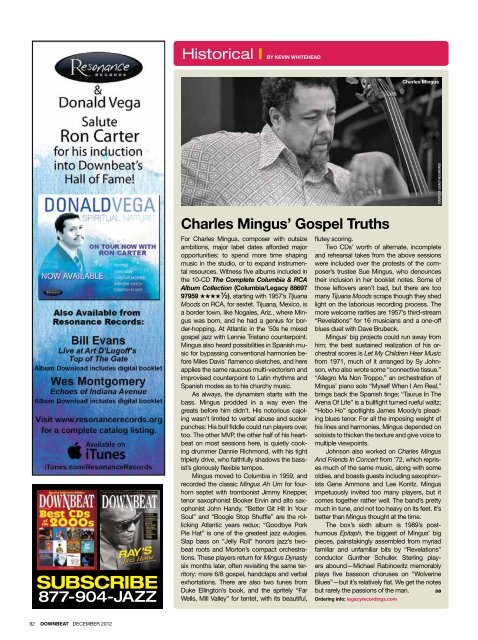Ron Carter Esperanza Spalding - Downbeat
Ron Carter Esperanza Spalding - Downbeat
Ron Carter Esperanza Spalding - Downbeat
Create successful ePaper yourself
Turn your PDF publications into a flip-book with our unique Google optimized e-Paper software.
Historical | By kevin whitehead<br />
Charles Mingus<br />
courtesy legacy recordings<br />
Subscribe<br />
877-904-JAZZ<br />
Charles Mingus’ Gospel Truths<br />
For Charles Mingus, composer with outsize<br />
ambitions, major label dates afforded major<br />
opportunities: to spend more time shaping<br />
music in the studio, or to expand instrumental<br />
resources. Witness five albums included in<br />
the 10-CD The Complete Columbia & RCA<br />
Album Collection (Columbia/Legacy 88697<br />
97959 HHHH1/2), starting with 1957’s Tijuana<br />
Moods on RCA, for sextet. Tijuana, Mexico, is<br />
a border town, like Nogales, Ariz., where Mingus<br />
was born, and he had a genius for border-hopping.<br />
At Atlantic in the ’50s he mixed<br />
gospel jazz with Lennie Tristano counterpoint.<br />
Mingus also heard possibilities in Spanish music<br />
for bypassing conventional harmonies before<br />
Miles Davis’ flamenco sketches, and here<br />
applies the same raucous multi-vectorism and<br />
improvised counterpoint to Latin rhythms and<br />
Spanish modes as to his churchy music.<br />
As always, the dynamism starts with the<br />
bass. Mingus prodded in a way even the<br />
greats before him didn’t. His notorious cajoling<br />
wasn’t limited to verbal abuse and sucker<br />
punches: His bull fiddle could run players over,<br />
too. The other MVP, the other half of his heartbeat<br />
on most sessions here, is quietly cooking<br />
drummer Dannie Richmond, with his tight<br />
triplety drive, who faithfully shadows the bassist’s<br />
gloriously flexible tempos.<br />
Mingus moved to Columbia in 1959, and<br />
recorded the classic Mingus Ah Um for fourhorn<br />
septet with trombonist Jimmy Knepper,<br />
tenor saxophonist Booker Ervin and alto saxophonist<br />
John Handy. “Better Git Hit In Your<br />
Soul” and “Boogie Stop Shuffle” are the rollicking<br />
Atlantic years redux; “Goodbye Pork<br />
Pie Hat” is one of the greatest jazz eulogies.<br />
Slap bass on “Jelly Roll” honors jazz’s twobeat<br />
roots and Morton’s compact orchestrations.<br />
These players return for Mingus Dynasty<br />
six months later, often revisiting the same territory:<br />
more 6/8 gospel, handclaps and verbal<br />
exhortations. There are also two tunes from<br />
Duke Ellington’s book, and the spritely “Far<br />
Wells, Mill Valley” for tentet, with its beautiful,<br />
flutey scoring.<br />
Two CDs’ worth of alternate, incomplete<br />
and rehearsal takes from the above sessions<br />
were included over the protests of the composer’s<br />
trustee Sue Mingus, who denounces<br />
their inclusion in her booklet notes. Some of<br />
those leftovers aren’t bad, but there are too<br />
many Tijuana Moods scraps though they shed<br />
light on the laborious recording process. The<br />
more welcome rarities are 1957’s third-stream<br />
“Revelations” for 16 musicians and a one-off<br />
blues duet with Dave Brubeck.<br />
Mingus’ big projects could run away from<br />
him; the best sustained realization of his orchestral<br />
scores is Let My Children Hear Music<br />
from 1971, much of it arranged by Sy Johnson,<br />
who also wrote some “connective tissue.”<br />
“Allegro Ma Non Troppo,” an orchestration of<br />
Mingus’ piano solo “Myself When I Am Real,”<br />
brings back the Spanish tinge; “Taurus In The<br />
Arena Of Life” is a bullfight turned rueful waltz;<br />
“Hobo Ho” spotlights James Moody’s pleading<br />
blues tenor. For all the imposing weight of<br />
his lines and harmonies, Mingus depended on<br />
soloists to thicken the texture and give voice to<br />
multiple viewpoints.<br />
Johnson also worked on Charles Mingus<br />
And Friends In Concert from ’72, which reprises<br />
much of the same music, along with some<br />
oldies, and boasts guests including saxophonists<br />
Gene Ammons and Lee Konitz. Mingus<br />
impetuously invited too many players, but it<br />
comes together rather well. The band’s pretty<br />
much in tune, and not too heavy on its feet. It’s<br />
better than Mingus thought at the time.<br />
The box’s sixth album is 1989’s posthumous<br />
Epitaph, the biggest of Mingus’ big<br />
pieces, painstakingly assembled from myriad<br />
familiar and unfamiliar bits by “Revelations”<br />
conductor Gunther Schuller. Sterling players<br />
abound—Michael Rabinowitz memorably<br />
plays five bassoon choruses on “Wolverine<br />
Blues”—but it’s relatively flat. We get the notes<br />
but rarely the passions of the man. DB<br />
Ordering info: legacyrecordings.com<br />
92 DOWNBEAT DECEMBER 2012
















